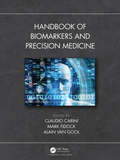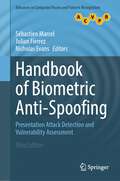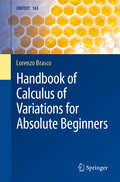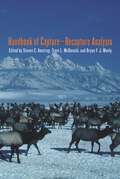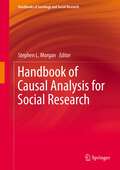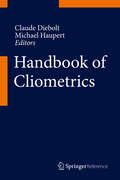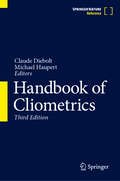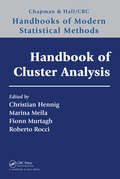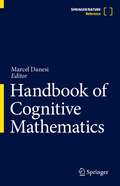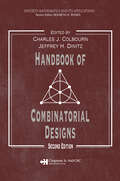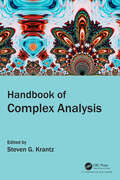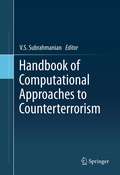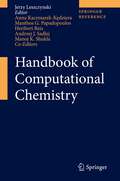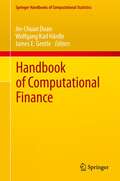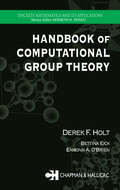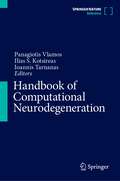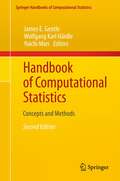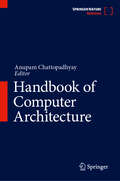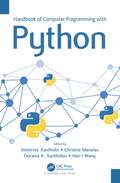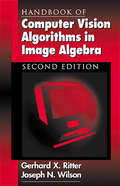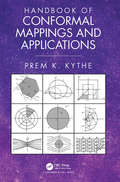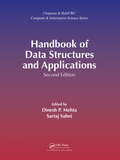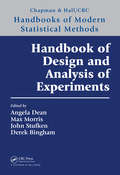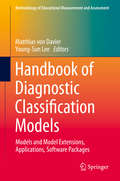- Table View
- List View
Handbook of Biomarkers and Precision Medicine
by Claudio Carini Mark Fidock Alain Van Gool"The field of Biomarkers and Precision Medicine in drug development is rapidly evolving and this book presents a snapshot of exciting new approaches. By presenting a wide range of biomarker applications, discussed by knowledgeable and experienced scientists, readers will develop an appreciation of the scope and breadth of biomarker knowledge and find examples that will help them in their own work." -Maria Freire, Foundation for the National Institutes of Health Handbook of Biomarkers and Precision Medicine provides comprehensive insights into biomarker discovery and development which has driven the new era of Precision Medicine. A wide variety of renowned experts from government, academia, teaching hospitals, biotechnology and pharmaceutical companies share best practices, examples and exciting new developments. The handbook aims to provide in-depth knowledge to research scientists, students and decision makers engaged in Biomarker and Precision Medicine-centric drug development. Features: Detailed insights into biomarker discovery, validation and diagnostic development with implementation strategies Lessons-learned from successful Precision Medicine case studies A variety of exciting and emerging biomarker technologies The next frontiers and future challenges of biomarkers in Precision Medicine Claudio Carini, Mark Fidock and Alain van Gool are internationally recognized as scientific leaders in Biomarkers and Precision Medicine. They have worked for decades in academia and pharmaceutical industry in EU, USA and Asia. Currently, Dr. Carini is Honorary Faculty at Kings’s College School of Medicine, London, UK. Dr. Fidock is Vice President of Precision Medicine Laboratories at AstraZeneca, Cambridge, UK. Prof.dr. van Gool is Head Translational Metabolic Laboratory at Radboud university medical school, Nijmegen, NL.
Handbook of Biometric Anti-Spoofing: Presentation Attack Detection and Vulnerability Assessment (Advances in Computer Vision and Pattern Recognition)
by Nicholas Evans Sébastien Marcel Julian FierrezThe third edition of this authoritative and comprehensive handbook is the definitive work on the current state of the art of Biometric Presentation Attack Detection (PAD) – also known as Biometric Anti-Spoofing. Building on the success of the previous editions, this thoroughly updated third edition has been considerably revised to provide even greater coverage of PAD methods, spanning biometrics systems based on face, fingerprint, iris, voice, vein, and signature recognition. New material is also included on major PAD competitions, important databases for research, and on the impact of recent international legislation. Valuable insights are supplied by a selection of leading experts in the field, complete with results from reproducible research, supported by source code and further information available at an associated website.Topics and features: reviews the latest developments in PAD for fingerprint biometrics, covering recent technologies like Vision Transformers, and review of competition series; examines methods for PAD in iris recognition systems, the use of pupil size measurement or multiple spectra for this purpose; discusses advancements in PAD methods for face recognition-based biometrics, such as recent progress on detection of 3D facial masks and the use of multiple spectra with Deep Neural Networks; presents an analysis of PAD for automatic speaker recognition (ASV), including a study of the generalization to unseen attacks; describes the results yielded by key competitions on fingerprint liveness detection, iris liveness detection, and face anti-spoofing; provides analyses of PAD in finger-vein recognition, in signature biometrics, and in mobile biometrics; includes coverage of international standards in PAD and legal aspects of image manipulations like morphing.This text/reference is essential reading for anyone involved in biometric identity verification, be they students, researchers, practitioners, engineers, or technology consultants. Those new to the field will also benefit from a number of introductory chapters, outlining the basics for the most important biometrics.This text/reference is essential reading for anyone involved in biometric identity verification, be they students, researchers, practitioners, engineers, or technology consultants. Those new to the field will also benefit from a number of introductory chapters, outlining the basics for the most important biometrics.
Handbook of CO₂ in Power Systems
by Panos M. Pardalos Niko A. Iliadis Mario V. Pereira Steffen Rebennack Qipeng P. ZhengThe Handbook of CO in Power Systems' objective is to include the state-of-the-art developments that occurred in power systems taking CO emission into account. The book includes power systems operation modeling with CO emissions considerations, CO market mechanism modeling, CO regulation policy modeling, carbon price forecasting, and carbon capture modeling. For each of the subjects, at least one article authored by a world specialist on the specific domain is included.
Handbook of Calculus of Variations for Absolute Beginners (UNITEXT #163)
by Lorenzo BrascoThe book aims at endowing any student with a survival toolkit to start safely diving into the realm of Calculus of Variations. In summary, the latter is a part of mathematical analysis devoted to minimization/maximization problems. A great effort has been made to present the themes and methods considered in the book in the simplest possible way: the reader will not find here general statements or proofs based on general abstract theories. In contrast, the main focus of the book is on introducing some key concepts "from scratch", by means of simple and meaningful explicit examples (including for instance, the classical isoperimetric and brachistocrone problems, as well as the boundary value problem for harmonic functions). In particular, the book is mainly (but not exclusively) designed to smoothly introduce the reader to the so-called Direct Method of the Calculus of Variations, which is a central concept in the field. Accordingly, a good part of the book is devoted to discussing spaces of weakly differentiable functions (i.e., Sobolev and Lipschitz functions), which are essential tools of the Direct Method. A long list of problems will guide the student through the study of the subject. Almost all the problems come with their fully detailed solutions. The book is complemented by four appendices, which contribute to making it self-contained, as well as to deepening the study of certain parts. Despite being designed for students, even the researchers in the field could find a reading of the book profitable, at least for certain parts concerning the properties of Sobolev spaces, functional inequalities of the Sobolev-Poincaré type, tricks to handle nonlinear elliptic PDEs, and a gentle introduction to some techniques of modern regularity theory for elliptic PDEs.
Handbook of Capture-Recapture Analysis
by Steven C. Amstrup Bryan F. J. Manly Trent L. McDonaldEvery day, biologists in parkas, raincoats, and rubber boots go into the field to capture and mark a variety of animal species. Back in the office, statisticians create analytical models for the field biologists' data. But many times, representatives of the two professions do not fully understand one another's roles. This book bridges this gap by helping biologists understand state-of-the-art statistical methods for analyzing capture-recapture data. In so doing, statisticians will also become more familiar with the design of field studies and with the real-life issues facing biologists. Reliable outcomes of capture-recapture studies are vital to answering key ecological questions. Is the population increasing or decreasing? Do more or fewer animals have a particular characteristic? In answering these questions, biologists cannot hope to capture and mark entire populations. And frequently, the populations change unpredictably during a study. Thus, increasingly sophisticated models have been employed to convert data into answers to ecological questions. This book, by experts in capture-recapture analysis, introduces the most up-to-date methods for data analysis while explaining the theory behind those methods. Thorough, concise, and portable, it will be immensely useful to biologists, biometricians, and statisticians, students in both fields, and anyone else engaged in the capture-recapture process.
Handbook of Causal Analysis for Social Research
by Stephen L. MorganWhat constitutes a causal explanation, and must an explanation be causal? What warrants a causal inference, as opposed to a descriptive regularity? What techniques are available to detect when causal effects are present, and when can these techniques be used to identify the relative importance of these effects? What complications do the interactions of individuals create for these techniques? When can mixed methods of analysis be used to deepen causal accounts? Must causal claims include generative mechanisms, and how effective are empirical methods designed to discover them? The Handbook of Causal Anlaysis for Social Research tackles these questions with nineteen chapters from leading scholars in sociology, statistics, public health, computer science, and human development.
Handbook of Cliometrics
by Claude Diebolt Michael HaupertThe Handbook of Cliometrics is a milestone in the field of historical economics and econometric history through its emphasis on the concrete contribution of cliometrics to our knowledge in economics and history. The articles in the handbook authored by the leading scholars in the fields, stress the usefulness of cliometrics for economists, historians and social scientists in general. The Handbook offers a comprehensive coverage of topics with each article providing an overview of the contributions of cliometrics to a particular topic. The Handbook sets a new standard of quality in the field by offering a world-wide forum of discussion in cliometrics.
Handbook of Cliometrics
by Claude Diebolt Michael HaupertThis handbook is a milestone in the field of historical economics and econometric history through its emphasis on the concrete contribution of cliometrics to our knowledge in economics and history. The articles in the handbook authored by the leading scholars in the fields, stress the usefulness of cliometrics for economists, historians and social scientists in general. The handbook offers a comprehensive coverage of topics with each article providing an overview of the contributions of cliometrics to a particular topic. The handbook has set a new standard of quality in the field by offering a world-wide forum of discussion in cliometrics. This updated and extended third edition of the handbook of cliometrics offers a substantially enlarged collection of articles and thus stresses its unique position as authoritative reference work in this field.
Handbook of Cluster Analysis (Chapman & Hall/CRC Handbooks of Modern Statistical Methods)
by Fionn Murtagh Marina Meila Roberto Rocci Christian HennigHandbook of Cluster Analysis provides a comprehensive and unified account of the main research developments in cluster analysis. Written by active, distinguished researchers in this area, the book helps readers make informed choices of the most suitable clustering approach for their problem and make better use of existing cluster analysis tools.The
Handbook of Cognitive Mathematics
by Marcel DanesiCognitive mathematics provides insights into how mathematics works inside the brain and how it is interconnected with other faculties through so-called blending and other associative processes. This handbook is the first large collection of various aspects of cognitive mathematics to be amassed into a single title, covering decades of connection between mathematics and other figurative processes as they manifest themselves in language, art, and even algorithms. It will be of use to anyone working in math cognition and education, with each section of the handbook edited by an international leader in that field.
Handbook of Combinatorial Designs (Discrete Mathematics and Its Applications)
by Charles J. Colbourn Jeffrey H. DinitzContinuing in the bestselling, informative tradition of the first edition, the Handbook of Combinatorial Designs, Second Edition remains the only resource to contain all of the most important results and tables in the field of combinatorial design. This handbook covers the constructions, properties, and applications of designs as well as existence
Handbook of Complex Analysis
by Steven G. KrantzIn spite of being nearly 500 years old, the subject of complex analysis is still today a vital and active part of mathematics. There are important applications in physics, engineering, and other aspects of technology. This Handbook presents contributed chapters by prominent mathematicians, including the new generation of researchers. More than a compilation of recent results, this book offers students an essential stepping-stone to gain an entry into the research life of complex analysis. Classes and seminars play a role in this process. More, though, is needed for further study. This Handbook will play that role. This book is also a reference and a source of inspiration for more seasoned mathematicians—both specialists in complex analysis and others who want to acquaint themselves with current modes of thought.The chapters in this volume are authored by leading experts and gifted expositors. They are carefully crafted presentations of diverse aspects of the field, formulated for a broad and diverse audience. This volume is a touchstone for current ideas in the broadly construed subject area of complex analysis. It should enrich the literature and point in some new directions.
Handbook of Computational Approaches to Counterterrorism
by V. S. SubrahmanianTerrorist groups throughout the world have been studied primarily through the use of social science methods. However, major advances in IT during the past decade have led to significant new ways of studying terrorist groups, making forecasts, learning models of their behaviour, and shaping policies about their behaviour. Handbook of Computational Approaches to Counterterrorism provides the first in-depth look at how advanced mathematics and modern computing technology is shaping the study of terrorist groups. This book includes contributions from world experts in the field, and presents extensive information on terrorism data sets, new ways of building such data sets in real-time using text analytics, introduces the mathematics and computational approaches to understand terror group behaviour, analyzes terror networks, forecasts terror group behaviour, and shapes policies against terrorist groups. Auxiliary information will be posted on the book's website. This book targets defence analysts, counter terror analysts, computer scientists, mathematicians, political scientists, psychologists, and researchers from the wide variety of fields engaged in counter-terrorism research. Advanced-level students in computer science, mathematics and social sciences will also find this book useful.
Handbook of Computational Chemistry
by Jerzy LeszczynskiThe role the Handbook of Computational Chemistry is threefold. It is primarily intended to be used as a guide that navigates the user through the plethora of computational methods currently in use; it explains their limitations and advantages; and it provides various examples of their important and varied applications. This reference work is presented in three volumes. Volume I introduces the different methods used in computational chemistry. Basic assumptions common to the majority of computational methods based on molecular, quantum, or statistical mechanics are outlined and special attention is paid to the limits of their applicability. Volume II portrays the applications of computational methods to model systems and discusses in detail molecular structures, the modelling of various properties of molecules and chemical reactions. Both ground and excited states properties are covered in the gas phase as well as in solution. This volume also describes Nanomaterials and covers topics such as clusters, periodic, and nano systems. Special emphasis is placed on the environmental effects of nanostructures. Volume III is devoted to the important class of Biomolecules. Useful models of biological systems considered by computational chemists are provided and RNA, DNA and proteins are discussed in detail. This volume presents examples of calcualtions of their properties and interactions and reveals the role of solvents in biologically important reactions as well as the structure function relationship of various classes of Biomolecules.
Handbook of Computational Finance
by Wolfgang Karl Härdle James E. Gentle Jin-Chuan DuanAny financial asset that is openly traded has a market price. Except for extreme market conditions, market price may be more or less than a "fair" value. Fair value is likely to be some complicated function of the current intrinsic value of tangible or intangible assets underlying the claim and our assessment of the characteristics of the underlying assets with respect to the expected rate of growth, future dividends, volatility, and other relevant market factors. Some of these factors that affect the price can be measured at the time of a transaction with reasonably high accuracy. Most factors, however, relate to expectations about the future and to subjective issues, such as current management, corporate policies and market environment, that could affect the future financial performance of the underlying assets. Models are thus needed to describe the stochastic factors and environment, and their implementations inevitably require computational finance tools.
Handbook of Computational Group Theory (Discrete Mathematics and Its Applications)
by Derek F. Holt Bettina Eick Eamonn A. O'BrienThe origins of computation group theory (CGT) date back to the late 19th and early 20th centuries. Since then, the field has flourished, particularly during the past 30 to 40 years, and today it remains a lively and active branch of mathematics. The Handbook of Computational Group Theory offers the first complete treatment of all the fundame
Handbook of Computational Neurodegeneration
by Ilias S. Kotsireas Panagiotis Vlamos Ioannis TarnanasThe Handbook of Computational Neurodegeneration provides a comprehensive overview of the field and thus bridges the gap between standard textbooks of research on neurodegeneration and dispersed publications for specialists that have a narrowed focus on computational methods to study this complicated process. The handbook reviews the central issues and methodological approaches related to the field for which the reader pursues a thorough overview. It also conveys more advanced knowledge, thus serving both as an introductory text and as a starting point for an in-depth study of a specific area, as well as a quick reference source for the expert by reflecting the state of the art and future prospects. The book includes topics that are usually missing in standard textbooks and that are only marginally represented in the specific literature. The broad scope of this handbook is reflected by five major parts that facilitate an integration of computational concepts, methods and applications in the study of neurodegeneration. Each part is intended to stand on its own, giving an overview of the topic and the most important problems and approaches, which are supported by examples, practical applications, and proposed methodologies. The basic concepts and knowledge, standard procedures and methods are presented, as well as recent advances and new perspectives.
Handbook of Computational Statistics
by Wolfgang Karl Härdle James E. Gentle Yuichi MoriThe Handbook of Computational Statistics - Concepts and Methods (second edition) is a revision of the first edition published in 2004, and contains additional comments and updated information on the existing chapters, as well as three new chapters addressing recent work in the field of computational statistics. This new edition is divided into 4 parts in the same way as the first edition. It begins with "How Computational Statistics became the backbone of modern data science" (Ch.1): an overview of the field of Computational Statistics, how it emerged as a separate discipline, and how its own development mirrored that of hardware and software, including a discussion of current active research. The second part (Chs. 2 - 15) presents several topics in the supporting field of statistical computing. Emphasis is placed on the need for fast and accurate numerical algorithms, and some of the basic methodologies for transformation, database handling, high-dimensional data and graphics treatment are discussed. The third part (Chs. 16 - 33) focuses on statistical methodology. Special attention is given to smoothing, iterative procedures, simulation and visualization of multivariate data. Lastly, a set of selected applications (Chs. 34 - 38) like Bioinformatics, Medical Imaging, Finance, Econometrics and Network Intrusion Detection highlight the usefulness of computational statistics in real-world applications.
Handbook of Computer Architecture
by Anupam ChattopadhyayThis handbook presents the key topics in the area of computer architecture covering from the basic to the most advanced topics, including software and hardware design methodologies. It will provide readers with the most comprehensive updated reference information covering applications in single core processors, multicore processors, application-specific processors, reconfigurable architectures, emerging computing architectures, processor design and programming flows, test and verification. This information benefits the readers as a full and quick technical reference with a high-level review of computer architecture technology, detailed technical descriptions and the latest practical applications.
Handbook of Computer Programming with Python
by Dimitrios XanthidisThis handbook provides a hands-on experience based on the underlying topics, and assists students and faculty members in developing their algorithmic thought process and programs for given computational problems. It can also be used by professionals who possess the necessary theoretical and computational thinking background but are presently making their transition to Python. Key Features: • Discusses concepts such as basic programming principles, OOP principles, database programming, GUI programming, application development, data analytics and visualization, statistical analysis, virtual reality, data structures and algorithms, machine learning, and deep learning. • Provides the code and the output for all the concepts discussed. • Includes a case study at the end of each chapter. This handbook will benefit students of computer science, information systems, and information technology, or anyone who is involved in computer programming (entry-to-intermediate level), data analytics, HCI-GUI, and related disciplines.
Handbook of Computer Vision Algorithms in Image Algebra
by Joseph N. Wilson Gerhard X. RitterImage algebra is a comprehensive, unifying theory of image transformations, image analysis, and image understanding. In 1996, the bestselling first edition of the Handbook of Computer Vision Algorithms in Image Algebra introduced engineers, scientists, and students to this powerful tool, its basic concepts, and its use in the concise representation
Handbook of Conformal Mappings and Applications
by Prem K. KytheThe subject of conformal mappings is a major part of geometric function theory that gained prominence after the publication of the Riemann mapping theorem — for every simply connected domain of the extended complex plane there is a univalent and meromorphic function that maps such a domain conformally onto the unit disk. The Handbook of Conformal Mappings and Applications is a compendium of at least all known conformal maps to date, with diagrams and description, and all possible applications in different scientific disciplines, such as: fluid flows, heat transfer, acoustics, electromagnetic fields as static fields in electricity and magnetism, various mathematical models and methods, including solutions of certain integral equations.
Handbook of Data Structures and Applications (Chapman & Hall/CRC Computer and Information Science Series)
by Dinesh P. Mehta and Sartaj SahniThe Handbook of Data Structures and Applications was first published over a decade ago. This second edition aims to update the first by focusing on areas of research in data structures that have seen significant progress. While the discipline of data structures has not matured as rapidly as other areas of computer science, the book aims to update those areas that have seen advances. Retaining the seven-part structure of the first edition, the handbook begins with a review of introductory material, followed by a discussion of well-known classes of data structures, Priority Queues, Dictionary Structures, and Multidimensional structures. The editors next analyze miscellaneous data structures, which are well-known structures that elude easy classification. The book then addresses mechanisms and tools that were developed to facilitate the use of data structures in real programs. It concludes with an examination of the applications of data structures. Four new chapters have been added on Bloom Filters, Binary Decision Diagrams, Data Structures for Cheminformatics, and Data Structures for Big Data Stores, and updates have been made to other chapters that appeared in the first edition.The Handbook is invaluable for suggesting new ideas for research in data structures, and for revealing application contexts in which they can be deployed. Practitioners devising algorithms will gain insight into organizing data, allowing them to solve algorithmic problems more efficiently.
Handbook of Design and Analysis of Experiments (Chapman & Hall/CRC Handbooks of Modern Statistical Methods)
by Max Morris Angela Dean John Stufken Derek BinghamThis carefully edited collection synthesizes the state of the art in the theory and applications of designed experiments and their analyses. It provides a detailed overview of the tools required for the optimal design of experiments and their analyses. The handbook covers many recent advances in the field, including designs for nonlinear models and algorithms applicable to a wide variety of design problems. It also explores the extensive use of experimental designs in marketing, the pharmaceutical industry, engineering and other areas.
Handbook of Diagnostic Classification Models: Models and Model Extensions, Applications, Software Packages (Methodology of Educational Measurement and Assessment)
by Matthias Von Davier Young-Sun LeeThis handbook provides an overview of major developments around diagnostic classification models (DCMs) with regard to modeling, estimation, model checking, scoring, and applications. It brings together not only the current state of the art, but also the theoretical background and models developed for diagnostic classification. The handbook also offers applications and special topics and practical guidelines how to plan and conduct research studies with the help of DCMs. Commonly used models in educational measurement and psychometrics typically assume a single latent trait or at best a small number of latent variables that are aimed at describing individual differences in observed behavior. While this allows simple rankings of test takers along one or a few dimensions, it does not provide a detailed picture of strengths and weaknesses when assessing complex cognitive skills. DCMs, on the other hand, allow the evaluation of test taker performance relative to a potentially large number of skill domains. Most diagnostic models provide a binary mastery/non-mastery classification for each of the assumed test taker attributes representing these skill domains. Attribute profiles can be used for formative decisions as well as for summative purposes, for example in a multiple cut-off procedure that requires mastery on at least a certain subset of skills. The number of DCMs discussed in the literature and applied to a variety of assessment data has been increasing over the past decades, and their appeal to researchers and practitioners alike continues to grow. These models have been used in English language assessment, international large scale assessments, and for feedback for practice exams in preparation of college admission testing, just to name a few. Nowadays, technology-based assessments provide increasingly rich data on a multitude of skills and allow collection of data with respect to multiple types of behaviors. Diagnostic models can be understood as an ideal match for these types of data collections to provide more in-depth information about test taker skills and behavioral tendencies.
